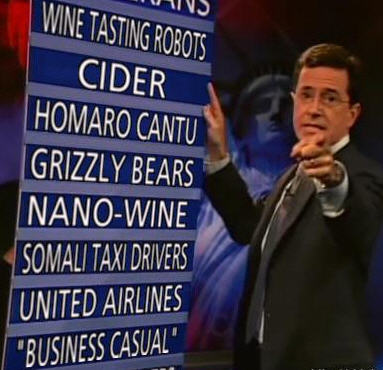Dr Vino's wine blog
wine talk that goes down easy
Stomp, Portuguese style
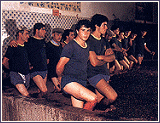 You know that caricature of someone in a vat, crushing grapes by foot to start the fermentation process? You know, the image long-ago phased out in practice for wine? Well, it turns out that nothing beats the foot in Portugal for making port.
You know that caricature of someone in a vat, crushing grapes by foot to start the fermentation process? You know, the image long-ago phased out in practice for wine? Well, it turns out that nothing beats the foot in Portugal for making port.
Only two percent of all port is still foot-crushed and it is mostly the best ports available, vintage ports. Despite some negative associations, feet are especially good at crushing the skin without crushing the seed–filled with bitter tannins–as well.
Electricity came late to the upper Douro Valley. When it did, in the 1980s, labor prices were high so producers rushed to adopt automated crushing and stainless steel closed-top fermenters. Quality fell. There was just something about those feet. Or oxygen.
The traditional lagares are made of granite and are wide, open-top vats or troughs. Somehow the exposure to oxygen provided a slight degree of oxidation that was more appealing in port, a fortified wine. David Fonseca Guimaraens told me today that his company, the Fladgate Partnership, was among the first in the region to develop mechanized foot-like pistons in open-top stainless steel vats. I didn’t ask if the pistons had toes. But Guimaraens did say that the added labor of foot crushing made it twice as expensive as mechanization.
 I tasted a sample of each of the three methods, foot-trodden from a stone lagar, piston-trodden in a stainless steel tank, and closed top.
I tasted a sample of each of the three methods, foot-trodden from a stone lagar, piston-trodden in a stainless steel tank, and closed top.
The last one was quite hollow in the middle with elevated, aggressive tannins. The piston-pressed one was much more complete, with a beginning a middle and an end with good freshness. But it was the lagar sample that had the most layers of complexity. Then there was a blind sample just to see if I was paying attention. Fortunately I got it right (the odds were good though).
In the ongoing discussion about wine and technology, it’s a cute story of the advantages of simplicity. But technology is on the march. Guimaraens says in five years, the pistons could catch the feet. They’d better keep running.
Bringing closure? A screwcap-cork showdown
Five years ago, Randall Grahm staged a funeral for the cork. The great marketer and label designer behind Big House Red and Ca del Solo among other brands staged a processional for his last cork at Grand Central Station of all places. From then on, all of his wines have been bottled “en screw.â€
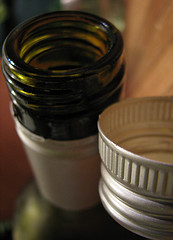 Since enjoying wine is in many ways a race against time (and oxygen), how a bottle of wine gets sealed is of utmost importance. Corks have their detractors since they can introduce the noxious chemical TCA that makes wines “corked.†Further, the pieces of tree bark can lose their elasticity as they age letting in wine’s nemesis, oxygen.
Since enjoying wine is in many ways a race against time (and oxygen), how a bottle of wine gets sealed is of utmost importance. Corks have their detractors since they can introduce the noxious chemical TCA that makes wines “corked.†Further, the pieces of tree bark can lose their elasticity as they age letting in wine’s nemesis, oxygen.
Screwcaps, by contrast, can provide such a tight seal that no oxygen gets in and there is no problem with TCA. Many proponents of screwcaps (or Stelvin closures, if you must) might suggest that the only thing standing between them and domination of the wine world is consumer resistance since wines bottled “en screw†have typically been seen as more downmarket. And what would you do with your $100 corkscrew if you only had to twist the cap off?
Screwcaps appear to be so controversial with their partisans for and against, you might think it impossible to find a producer who goes both ways. Fortunately the Wine Media Guild was able to find several examples of the same wines bottled under both closures for the March tasting.
Michel Laroche attended the tasting as speaker to share his experiences as well as several of his wines bottled under both closures. Laroche is a fifth generation winemaker from Chablis who has run his family firm since 1967 and now also makes wine in the Languedoc, Chile and South Africa.
For Laroche the transition to screwcaps started in 2001 when an unacceptably large amount of his wine was sold unknowingly with TCA that came through corks. Placing the estimate at 10 percent of his production that year, he expressed frustration because he said that consumers never complained so he didn’t know if they thought that flawed wine was actually his style.
So in 2002 he took action. He set up an alternative bottling line and bottled three percent of his production under screwcaps. He bottled the same day and from the same vats. He brought four of his wines that run the gamut of his line for us to taste, with a bottle under each closure.
The difference was shocking. Read more…
Enomatic rewards New Yorkers
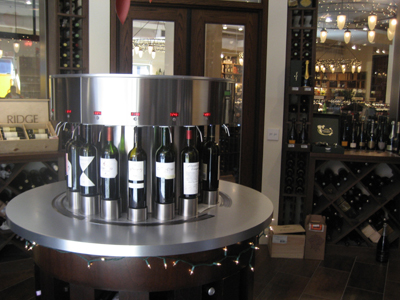 The fact that the enomatic, a $10,000 machine that spits out wine pours, has landed in New York is not news (unlike in Fairfax, VA): Union Square Wines installed six of the machines when they moved to their new location (map it) last summer. What’s news is that it is the only store in New York to do so. Why?
The fact that the enomatic, a $10,000 machine that spits out wine pours, has landed in New York is not news (unlike in Fairfax, VA): Union Square Wines installed six of the machines when they moved to their new location (map it) last summer. What’s news is that it is the only store in New York to do so. Why?
You can largely thank New York’s confusing laws on wine retailing, which prevent charging for wine samples among other things. In states with more permissive laws on tasting, enomatic machines can be spotted in wine shops that charge for samples. But in New York, charging anything for drinking on premises requires a different license. Thus it’s hard to make for a retailer to make economically viable the expensive piece of burnished stainless steel that is the enomatic. (But it does mean a lot of free wine for consumers around town.)
But Union Square Wines took the plunge and I decided to put them to the test. I strode in last weekend and asked for a card. Not so easy, it turns out. You have to be an existing customer–it’s structured as a “reward” system. Well, I’ve bought wine at the store before, I replied. “But do you have the card?” Ah, no. A purchase is required and each dollar spent accumulates 5 points, which can be deducted from the card at the enomatics.
So seeing that 40 points could get me a couple of tastes, I splurged on an $8 wine. Then I had to take my receipt to another desk across the store (no plans for streamlining this at one register) where a staffer mercifully took pity on me and gave me 200 points instead of the 40 I was due.
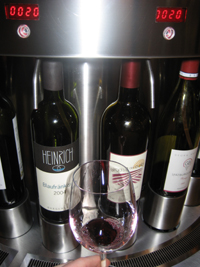 Then I hit the machines. The pours were SMALL. But they were FRESH. It only took me a shot of riesling, gewurztraminer, some rustic French red, and a bonarda from Argentina to realize that the number of points deducted was the equivalent to the price in dollars of the whole bottle. Too bad I didn’t have enough for the 225 point Barolo in the front room. Net-net the enomatic is a way to get fresh, free wine served on demand. Just, for the sake of the NY regulators, don’t think of it as a bar!
Then I hit the machines. The pours were SMALL. But they were FRESH. It only took me a shot of riesling, gewurztraminer, some rustic French red, and a bonarda from Argentina to realize that the number of points deducted was the equivalent to the price in dollars of the whole bottle. Too bad I didn’t have enough for the 225 point Barolo in the front room. Net-net the enomatic is a way to get fresh, free wine served on demand. Just, for the sake of the NY regulators, don’t think of it as a bar!
* * *
On a related note, the WSJ had a story yesterday about the potential demise of the bar car on Metro-North trains. Installing enomatics on the trains could be an excellent use of the machine that substitutes capital for labor.
Who’s threatening us now: nanotechnology!
Tired of high alcohol levels in your wine? Want to tone down the “fresh cut grass” in your sauvignon blanc? Heck, want to turn your red wine into white?
Behold the future is here! Kraft brings you “programmable” food and beverages. Roll the tape from The Observer (UK):
The processed-food giant Kraft and a group of research laboratories are busy working towards ‘programmable food’. One product they are working on is a colourless, tasteless drink that you, the consumer, will design after you’ve bought it. You’ll decide what colour and flavour you’d like the drink to be, and what nutrients it will have in it, once you get home. You’ll zap the product with a correctly-tuned microwave transmitter – presumably Kraft will sell you that, too.
This will activate nano-capsules – each one about 2,000 times smaller than the width of a hair – containing the necessary chemicals for your choice of drink: green-hued, blackcurrant-flavoured with a touch of caffeine and omega-3 oil, say. They will dissolve while all the other possible ingredients will pass unused through your body, in their nano-capsules.
While the Observer article only mentions nanotechnolgy as being able to “turn red wine into white,” Neil Pendock cranks it up on wine.co.za
Goodbye cork taint, hello programmable alcohol levels – nanotechnology can deliver solutions to the age-old problems of wine… Feel like a glass of Sauvignon Blanc? Switch on the green peppers (capsicum if you feel in an Aussie or pretentious South African mood). Syrah? Dial up some wood smoke, sweaty saddles and spice.
I’ve had wines that express the terroir and wines designed for focus groups. But I’ve never tried a do-it-almost-yourself (with-the-help-of-microwave) “wine”! Nano-wine, I’m putting you on notice!
Related: “Who’s threatening us now: United Airlines!”
 tags: wine | nanotechnology
tags: wine | nanotechnology
Enomatic lands in Fairfax VA
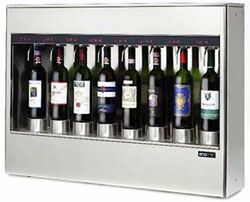 This just in from a Washington, DC tipster:
This just in from a Washington, DC tipster:
The new Whole Foods store that recently opened in Fairfax has a secret wine tasting room and cellar upstairs from their main floor wine area. It’s not marked or advertised but upstairs are dozens of by the pour/nitrogen flushed bottles of all manner of wines in all price ranges. The customer buys a card that is inserted into the card reader at the selected wine and then designates the pour size. The cost by the pour is deducted from the clients card. A great way to sample some primo vino and I expect it will evolve into a destination for those that really want to expand their horizons in what would otherwise be inaccessible wines! I need a machine like that at my house!
A call to the store revealed that, yes, the store has ten of the Italian “enomatic” machines that substitute capital for bartenders. Each machine costs $10,000 and holds eight bottles. The 30-seat upstairs “enoteca” with a “bridge view” of the store itself is not so much a secret as it is yet to be signposted–the store opened on January 17. Props to you, tipster, for having sniffed it out.
Pours are available in one, three, and five ounce sizes and range from $1 to $30 an ounce for the 1996 Domaine de la Romanee Conti Echezaux (find this wine: WF price is $600 a bottle; another nearby vendor has it for $350 if you decide to go nuts and buy a whole bottle). Cheese and olive plates can be ordered from downstairs–no word on when this food delivery will be automated. Perhaps the best news is that the members of the George Mason community and other locals will be able to tap the vino seven days a week from 11 AM – 9 PM.
Whole Foods Market – Fairfax (Fair Lakes)
go to beer and wine department at the back and climb the staircase
4501 Market Commons Dr
Fairfax, VA 22033
Phone: 703.222.2058
 tags: wine | whole foods | enomatic
tags: wine | whole foods | enomatic
Who’s threatening us now: robots!
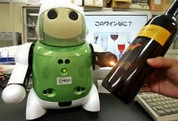 If you’re at a loss for words when it comes to describing wine, you now have another choice besides reading a book or good old-fashioned trial and error: robots!
If you’re at a loss for words when it comes to describing wine, you now have another choice besides reading a book or good old-fashioned trial and error: robots!
Yes, the 2-ft tall creature to the right claims to be able to tell good wine from bad and even discern particular wine brands. How about that for your next party trick?
There are only two problems standing in the way of this robot annhilating sommeliers and wine geeks in general. One: price. The AP reports one of the researchers who developed the robot as saying it costs “about as much as a new car,” though they are trying to get that down to a more manageable $1,000.
Second: errors. From the AP story:
Some of the mistakes it makes would get a human sommelier fired — or worse.
When a reporter’s hand was placed against the robot’s taste sensor, it was identified as prosciutto. A cameraman was mistaken for bacon.
We’re safe for now! But we must not let our guard down against these cyborgs in the cellar.
Image: AP
Grapes on the half shell
Which wine goes with oysters? A crisp sauvignon blanc is likely to be your reply. Yesterday, I had merlot and oysters.
Not that I ate oysters and drank the merlot mind you. But they were together.
I attended a seminar with Steve Smith, vineyard manager, winemaker, partner and all-around grape guru at Craggy Range. Founded in 2001 in the cool Gimblett Gravels area (Hawke’s Bay) of New Zealand, Craggy Range also makes single vineyard wines from Otago and Martinborough.
I tried two barrel samples of merlot from Gimblett Gravels. One was more plush, more merlot-like. The other was tightly wound and high in acidity–not bad for a barrel sample. Were they from different vineyards? In fact, no, they were even from the same block of the same vineyard.
To explain the difference, Steve had me shine a flashlight on a gray rock from the vineyard. Pretty dull. Then he sprinkled some crushed oyster shells on it and had me shine the flashlight on it again. The reflection was brighter.
Steve had done the same thing in the vineyard. He had sprinkled half of the vineyard block with crushed oyster shells, which then reflected some sun light onto the grapes and leaves that were normally obscured. The barrel sample made from the oyster side of the vineyard was the one that was more plush and had greater depth.
Grapes grown on the half shell? It could be the wave of the future.
www.cragyrange.com
* * * * *
Craggy Range, “Sophia” 2004. Find this wine
This blend of merlot and cabernet franc has a rich, dark color with aromas of blueberry and cigar box. The firm tannins give it a good structure for aging and a good finish. I’d love to taste it next to some blended wines of the same grapes from Bordeaux and Long Island to tell the effects of terroir–oysters or not.
 tags: wine | vineyards | Craggy Range | oysters
tags: wine | vineyards | Craggy Range | oysters
Wireless message in a bottle
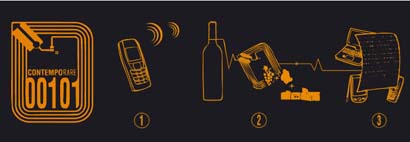 Riders of public transport in Chicago or Oslo know RFID technology. Bump your wallet at the turnstile and off you go–no fumbling to swipe cards. Same with skiers at some ski resorts. And drivers in the Northeast know the technology as well through E-ZPass toll collection.
Riders of public transport in Chicago or Oslo know RFID technology. Bump your wallet at the turnstile and off you go–no fumbling to swipe cards. Same with skiers at some ski resorts. And drivers in the Northeast know the technology as well through E-ZPass toll collection.
The same technology is coming to wine. Through an RFID sensor placed in the (synthetic) cork, importers, stores and consumers can now give each bottle a unique ID. While barcodes SKUs work for all the bottles of a certain wine as a group, this technology gives each individual bottle a unique–and unchangeable–ID. And unlike bar codes, boxes don’t have to be opened nor bottles taken off shelves to see more info about the wine. You just need to wave an RFID reader, which even comes in some Nokia phones, about 2 inches from the bottle and voila, all the info gets displayed.
The implications for consumers could be big. At the cost of $0.50 each though to the winery, it’s most likely impact will be on higher-end wines. Given the problem of fraud at auction, this would put an end to wondering if you bought the real deal or not. Optional fields could trace the bottle’s previous owners and even track the hammer prices. Sadly though the technology is difficult to put into real corks and the uptake of synthetic corks in cult wines remains almost nonexistent. It is currently available in one wine, the Contemporare from Arnaldo-Caprai, an excellent sangiovese (find this wine).
But it could have an important impact on everyday drinking wines too. An optional setting could add a temperature sensor that tracks max and min temperatures during shipping. If consumers could buy a bottle with the knowledge that it hadn’t been cooked in transit, that’s something to which we could all raise a glass–and our RFID readers!
 tags: wine | wine technology | RFID
tags: wine | wine technology | RFID
